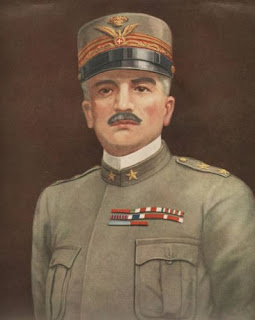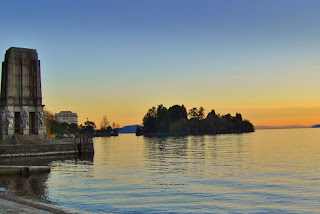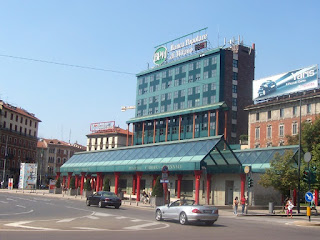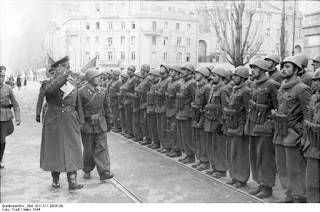First job was to arrest Mussolini
 |
| General Cerica was hand-picked as the Carabinieri commander to arrest Mussolini |
Mussolini was arrested on July 25 as he left his regular
meeting with the King, Vittorio Emanuele III, the day after the Fascist Grand
Council had voted to remove him from power.
The monarch had informed him that General Pietro Badoglio, former chief
of staff of the Italian army, would be replacing him as prime minister.
Cerica had been appointed Commander-in-Chief of the
Carabinieri, Italy’s para-military second police force, only two days
previously, succeeding General Azolino Hazon, who had been killed in a bombing
raid.
He was hand-picked for the job by General Vittorio Ambrosio,
who was party to secret plot among Carabinieri officers to depose Mussolini irrespective
of the Grand Council vote. They wanted a
commander who would not oppose the anti-Mussolini faction and would carry out
the arrest.
Cerica, in fact, shared their view of il Duce, blaming him
for leading Italy into a ruinous alliance with Germany in the Second World War
and eager for him to be removed, so that Italy could seek an armistice with the
Allies.
He was comfortable, therefore, to position himself with a brigade
of Carabinieri to arrest the dictator as he stepped out of the Palazzo Quirinale following
the meeting with the King.
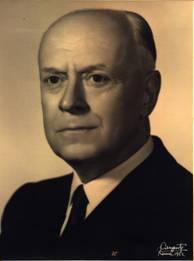 |
| Cerica fought with partisans after German army swept into Rome |
Later in the year, after the Badoglio Proclamation of September
8 informed the Italian population of the switch of allegiance, Cerica led a
battalion of Carabinieri in a battle with German troops on the Via Ostiense in Rome.
The Germans’ superior firepower won the day but Cerica
escaped and went into hiding, eventually joining up with partisans in Abruzzo
and fighting on the side of the Italian Resistance movement.
Once the Allies had liberated the area, he rejoined the
mainstream military, heading a department in the Army of the South, also known
as the Italian Liberation Corps, until the end of the war.
In 1945, in Florence, commissioned by the Minister of War
Alessandro Casati, he directed the liberation struggle against the Germans. After
the war was over, he was presented with the Medal for Freedom Silver Palm by
the US President, Harry S Truman.
Cerica, born to Pietro Felice Cerica and Luisa Villa in Alatri, was
set on a military career from an early age, entering a military academy soon
after leaving school. In 1906, he was commissioned as a second lieutenant and
joined the 74th Infantry Regiment, being promoted to full lieutenant in June
1909.
During June 1912, he was transferred to the Carabinieri
Corps. He participated in the First World War, attaining the rank of captain.
In September 1920, he was promoted to major and became a lieutenant colonel in 1927.
 |
| Allied tanks arrive in Rome |
Due to exceptional merit, he received the rank of brigadier
general later that year, becoming the chief of Carabinieri forces in Italian
East Africa. He served in the same capacity in Italian North Africa from July
1940 until February 1941. Cerica was posted back to Italy, attained the rank of
Divisional General in June 1942.
After leaving the Carabinieri, Cerica served as the
President of the Supreme Military Court from May 1947 to September 1951. He was
also a Member of the Senate for the Christian Democrats.
He died in Rome in April 1961, aged 75.
Alatri is a town in southern Lazio in the Ciociaria region
notable for its acropolis, a Roman citadel built on the top of a hill
surrounded by polygonal walls. The old
town within the walls contains many churches and ancient architectural structures,
including the Cathedral of San Paolo, which dates back to the 10th
century. Outside the citadel, the church
of Santa Maria Maggiore, in the main square, built on the site of an early
Christian temple of the fifth century, has a facade in the Romanesque-Gothic
style and hosts a number of works of art, including a wooden statue of the
Madonna di Costantinopoli of the 13th century and a fine triptych by Antonio da
Alatri (15th century), in the left nave.
The Via Ostiense follows the route of the Via Ostiensis, an
important road in ancient Rome that ran west 30km (19 miles) from the city of
Rome to its sea port of Ostia Antica, from which it took its name.
The road began near the Forum Boarium, ran between the Aventine Hill and the
Tiber River along its left bank, and left the city's Servian Walls
through the Porta Trigemina. When the later Aurelian Walls were built, the road
left the city through the Porta Ostiensis (Porta San Paolo). The modern Via
Ostiense is the main connecting route between Rome and Ostia, passing the important
basilica of Saint Paul Outside the Walls.




